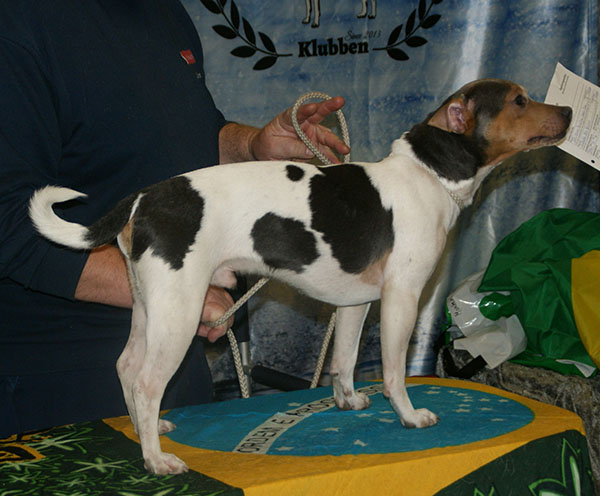Brazilian Terriers
Looking for the Brazilian Terrier, a Rare Breed, you can call your own?

If you love that tri-color appearance doubled with the feisty nature and fearlessness of a terrier, this breed may be just the one for you.
Playful and alert, but a terrier through and through, this dog has energy to spare. They need plenty of space to run.
They are aerobatic and intense; your Brazilian Terrier will catch every sound, small and large that is out of the ordinary and alert you immediately. For this reason, we give the Brazilian Terrier a 10 when it comes to watching dog abilities.
He will bark, and bark he will so be prepared for a dog that is as vocal as he is active. If you have a large yard, or want a partner to accompany you on your daily 3 mile walk, this one may be perfect for you.
Sorry, couch potatoes, this is not the breed for you.
Terrier tendencies come out in this breed so be prepared for digging, and chasing. They have a high prey drive. Intelligent and curious, he will want to be challenged.
He gets along well with other dogs but should not be left alone for extended periods of time unless you want to discover his creativity at work.
As a medium shedder, you will find dog hair in your house, but brushing will reduce this to manageable levels.
Developed in Brazil by crossing a Jack Russel Terrier with a Miniature Pincher and a large Chihuahua. The have been in existence for over a hundred years but are still very rare in the U.S.
The ideal living situation for this breed is with a high energy family with a large backyard. Encourage a rigorous romp in the yard to consume some of that extra energy. Games of fetch are also very popular for breeds that have high prey drives.
A daily walk is also critical to keeping this terrier in shape and mentally stimulated.
For these reasons, we do not recommend this breed as suitable for apartment living unless the owners are willing to spend considerable time exercising and training to reduce the barking tendency.
On the bright side, you will never need to worry about having a rat infestation. This is their raison d'être and they are experts in this area.
Keep them happy by giving them a job to do or at least something to occupy their time.
Without human intervention, most will become bored, and a bored dog always finds something to do, usually not something that most humans are like to approve.
Quick Facts
About the Brazilian Terrier
Other Names Used: Fox Paulistinha, Terrier Brasileriro
Affiliation: FCI (Federation Cynologique Internationale
Group 3, Section 1, Terrier Group
Size
Height: (13 to 15 inches) 33 to 40 CM: Females slightly smaller
Weight (Up to 22 lbs.) 6.5 to 10 Kg
Coat Type: Short Hair, Fine but not smooth; Sheds
Colors: Black or Blue with Tan and White
Country of Origin: Brazil
Activity Level: Active
Life Expectancy: 12 to 14 Years
Good with Children: Yes
Good
with other Pets: Yes, other dogs, but should not have small rodents in
the house; This breed finds them prey and as such would not be safe
around them.
History
This is a newer breed that dates back to around the 1880s.
This is about the time the Jack Russell Terrier was introduced into into Brazil primarily through young Brazilian students studying in England.
From there they were mated with Miniature Pinschers and large Chihuahuas, arriving at the breed we know today as the Brazilian Terrier. It is highly likely that other Brazilian breeds were used including Podengo Portugueso/Native American Dog crosses.
Other small breeds may have been mixed in, but there are little written records giving us specific details. The end results were a dog that was similar to existing terriers but unique at the same time.
They were larger than most English terriers, and their temperament was calmer allowing them to work as a group or pack rather than individually as was the case with many European Terrier types.
Brazilian plantation owners were impressed with Brazilian Terrier’s ability to catch vermin, which were serious threats to the agricultural crops of the day.
As a result, the Brazilian Terriers of the day helped increase crop yields, reduce the spread of communicable diseases and raise profits to the plantation owners.
The breed was slow to take on, but by 1994, it was given temporary credit with the FCI and then granted full recognition in in 2007. A few dogs have since been imported into Germany and the U.S.A.
The Brazilian Terrier remains popular in his country of origin but quite rare world wide.
Personality
This terrier has a similar character to the Jack Russel Terrier—very active, intelligent and alert. They are barkers and as such make excellent watchdogs—alerting you to any noise out of the ordinary.
They bark to get your attention. The biggest difference between the Brazilian and Other Terrier breeds is their tolerance for other dogs. Brazilian Terriers are far less dog aggressive than similar breeds making them an easy choice if one wishes to use them for hunting in packs.
To be fair, Brazilian Terriers are much more likely to be
tolerant of other pack members but not necessarily more loving of
others.
Training can be demanding because this breed is highly
intelligent, so a steady, consistent, confident method works best with
these dogs. Willful and determined are two adjectives used to describe
many an owner’s attempts at training. So that training may take time
and patience on the part of the human.
These dogs do best in a rural or suburban location due to their tendency to bark and their high energy level. Apartment or condo living is not recommended.
Due to their high level of intelligence, the Brazilian Terrier has performed very well in many dog sports including obedience and agility. This is not likely to be a good breed for inexperienced dog owners as they are not interesting in pleasing their humans and are considered to be stubborn and even obstinate.
These dogs do best in a rural or suburban location due to their tendency to bark and their high energy level. Apartment or condo living is not recommended.
Due to their high level of intelligence, the Brazilian Terrier has performed very well in many dog sports including obedience and agility. This is not likely to be a good breed for inexperienced dog owners as they are not interesting in pleasing their humans and are considered to be stubborn and even obstinate.
Grooming
Groomers would call this breed a bath dog breed meaning that a bath is about all that is really needed to keep them looking their best. Beyond the bath, nails need to be clipped, and teeth brushed.
During bath time, a quick check of the anal glands is in order and expressing them if needed is easiest done while in the tub.
Ears should be check and cleaned if necessary. This is an easy breed to groom which leaves plenty time for play, exercise, and training.
A good brushing once per week will reduce the amount of shedding in the home.
Health Concerns
This is a healthy breed often living upwards of 15years with 12 to 14 years being the norm.
Most common kinds have participated in at least one if not more breed specific health surveys, but because the Brazilian Terrier is so rare, little data is available for addressing the health concerns of the breed.
Just because a specific health concern has not been identified within a particular breed does not mean that it does not exist.
Most small dogs have some problems with the following issues, and if you are interested in obtaining a Brazilian Terrier, it is recommended that you do your due diligence.
Some of the health concerns that could pose a risk in this breed include:
Hip and Elbow Dysplasia which is common in many small breed dogs. Read more about Hip Dysplasia.
Luxating Patella: A common problem for most all the little Breed Dogs. Read more about Luxating Patella.
Epilepsy: A seizure disorder often called fits that recur regularly and is common in Jack Russell Terriers; a breed thought to be the foundation stock of Brazilian Terriers. Seizures.
Pros
- Highly intelligent, easy to train for the right person
- Good Watch Dog
- Good with other dogs
- Good with Children good with children and Families
- Take care of any vermin issues you might have
Cons
- High prey drive makes them difficult to live with if you have small pets
- Barking
- Super High Energy Level
Reference
FEDERATION CYNOLOGIQUE INTERNATIONALE
About Janice (author and voice behind this site)
Having lived with dogs and cats most of her life, Janice served as a veterinary technician for ten years in Maryland and twelve years as a Shih Tzu dog breeder in Ohio.
Her education includes undergraduate degrees in Psychology with a minor in biology, Early Childhood Education, and Nursing, and a master's in Mental Health Counseling.
She is a lifelong learner, a dog lover, and passionate about the welfare of animals. Her favorite breed for over 50 years has been the Shih Tzu, but she has also lived with Poodles, Maltese, Yorkshire Terriers, Beagles, English Bulldogs, Carin Terriers, and a Cocker Spaniel.
When not writing, reading, and researching dog-related topics, she likes to spend time with her eight Shih Tzu dogs, husband, and family, as well as knitting and crocheting. She is also the voice behind Miracle Shih Tzu and Smart-Knit-Crocheting
Does This Article Deserve Your Thumbs Up?
We always appreciate your support and encouragement. Your thumbs up means so much to us. Please like this article.
If you find this page or any page on Small Dog Place Helpful, or useful in anyway, I'd love it if you would click the small heart found on the bottom right of each page.
You can also share or bookmark this page -- just click on the:

Free Monthly Newsletter
Sign Up for Our Free Newsletter and get our Free Gift to You.
my E-book, The Top 10 Mistakes People Make When Choosing a Dog (and how to avoid them)





